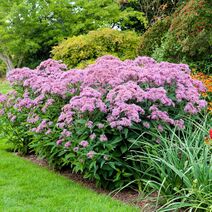Eupatorium maculatum
| Eupatorium maculatum | |
 | |
| Light: | |
| Moisture: | |
| Hardiness: | 5 |
| Soil pH: | 5.6-8.4 |
| Self Pollinated | |
| Height: | 5' |
| Blooms: | Mid Summer-Early Fall |
| Open Woods Forest | |
| Native to: | |
| Medicinal Rating: | |
| Tea: | Yes |
- For similar plants, see Joe Pye weed.
Eupatorium maculatum (common name: spotted Joe Pye weed)
Propagation: Seed - sow spring in a cold frame and only just cover the seed. Prick out the seedlings into individual pots when they are large enough to handle and plant them out into their permanent positions in the summer.
Division in spring or autumn[1]. Very easy, the clumps can be replanted direct into their permanent positions.
Cultivation: Succeeds in ordinary garden soil that is well-drained but moisture retentive in sun or part shade[2].
This species is hardy to about -25°c[3].
Plants seem to be immune to the predations of rabbits[4].
Range: South-eastern and Central N. America - Newfoundland to British Columbia to Washington and New York.
Habitat: Damp thickets, meadows, shores etc, usually on rich or calcareous soils from Quebec and southwards[5].
Medicinal: A tea made from the whole herb is diuretic[6]. It is used in the treatment of kidney complaints, painful urination, rheumatism etc[7][6]. The leaves and stems are harvested in the summer before the flower buds open, and are dried for later use[8].
A tea made from the roots is used in the treatment of fevers, colds, kidney and liver complaints, rheumatism etc[6][9]. It is said to have a tonic effect upon pregnant women[9] and is also said to induce sweating[6]. Externally, a decoction of the roots is used as a wash on rheumatic joints[9]. The roots are harvested in the autumn and dried for later use[8].
Usage: The stems have been used as straws[9].
Pollinators: Insects
Soil: Can grow in light, medium, and heavy soils.
Drainage: Prefers well drained soil.
Flower Type: Hermaphrodite
Links
References
- ↑ Sanders, Thomas. Popular Hardy Perennials. Collingridge, 1926.
- ↑ Huxley, Anthony. The New Royal Horticultural Society Dictionary of Gardening. MacMillan Press, 1992.
- ↑ Phillips, Roger and Martyn Rix. Perennials - The Definitve Reference. Pan Books, 1991.
- ↑ Thomas, Graham. Perennial Garden Plants. J. M. Dent & Sons, 1990.
- ↑ Lyndon, Merritt. Gray's Manual of Botany. American Book Co, 1950.
- ↑ 6.0 6.1 6.2 6.3 Foster, Steven and Billy Tatum. Medicinal Plants of Eastern and Central North America. Houghton Mifflin, 1990.
- ↑ Usher, George. A Dictionary of Plants Used by Man. Constable, 1974.
- ↑ 8.0 8.1 Bown, Deni. Royal Horticultural Society Encyclopaedia of Herbs and Their Uses. Dorling Kindersley, 1995.
- ↑ 9.0 9.1 9.2 9.3 Moerman, Daniel. Native American Ethnobotany. Timber Press, 1998.